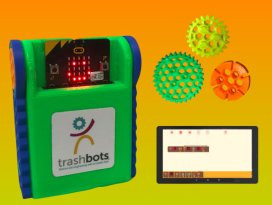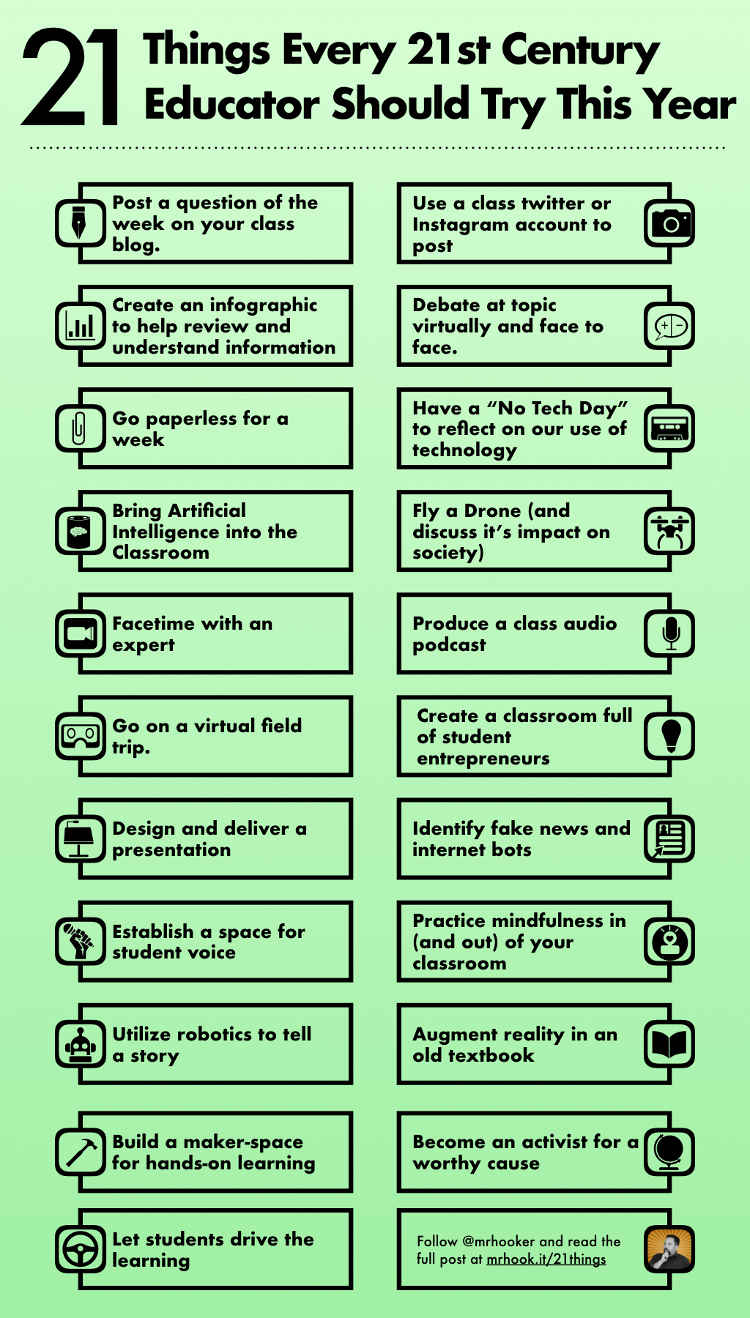21 Things Every 21st Century Educator Should Try This Year (2018 Version)

In 2014 I wrote what would be my most popular blog post ever. Little did I know what impact (both positive and negative) this post would have in the educational world. Part of the popularity of the post was due to the Sean Junkins created infographic that accompanied the post. For the most part, people tended to look at the infographic and pass judgement on whether or not these were things that teachers “should” do in the classroom without reading the blog at all. All that to say – Congratulations! If you are reading this post it means that you have taken the time to click on a link before just looking at the infographic.
Seeing that the world and education has changed (especially in the areas of technology, privacy, etc), I thought it might be a good time to rewrite the post before the start of the 2018 school year. Before I do that, a few disclaimers:
- I know that this is an ambitious list. We need ambition to move the needle in public education.
- While I love my friends in other countries, I’m not as familiar with their laws, so for the purpose of this post, put on your U.S. hat.
- Yes, technology costs money. Money that we are sorely lacking in public education. That said, I’ve tried to differentiate some items on this list require little to no money, just a growth mindset.
- The purpose of this list is not to shame teachers into trying EVERYTHING on the list. My hope is that it will generate one or two ideas for a teacher to try this year.
Ok, now that that’s out of the way, let’s move on to my 2018 version of “21 Things That Every Educator Should Try in the 21st Century”. A handful of these are carry overs from the 2014, but the majority are not. Many of the updates come from trends I’ve seen not only in education but also in the workplace like these Top 10 Skills Needed for the Fourth Industrial Revolution (from the World Economic Forum). Oh, and of course, check out the accompanying infographic as well…just be sure to read the full post before passing judgement.
[The Marriage Between IT & Curriculum]
1. Post a question of the week on your class blog
One of the best ways to engage student (and family) interaction with your classroom is to have a class blog. While these are becoming more common, I like the trend of having a weekly student “guest author” write up the ideas and learning objectives discussed in class. This is also a good place to discuss appropriate commenting behavior on blogs and websites.
2. Have a class twitter or Instagram account to post about the day’s learning
Tools and ideas to transform education. Sign up below.
Just like a blog only smaller. One of my Ed Techs (Ashley Pampe) actually created a “Social Media” team on her elementary campus. She vets and reviews all their images and blog entries before posting, but it’s an effective way for students to learn appropriate posting behaviors before they dive into the middle school world of social media. Ask parents to follow the account so they can also get a little insight into the happenings of the school day.
3. Create an infographic to help review and understand information
Infographics have become a part of everyday society. People are looking for information quickly and visually. Creating an infographic to review content is a powerful way to help those students that are visual learners. Taking this one step further – have students create an infographic as a way to convey their information on a subject. There are many free online tools out there to help with this but my favorite is Keynote (now with built in icons – it’s what I used to make the infographic for this post)
4. Debate a topic virtually and face to face
Lately the internet and social media have become a stomping ground for people to share their opinions, often in ways that they wouldn’t in a face to face conversation. We need to have students understand this medium as well as how to have an educated argument in person. Creating an environment where cordial discourse is encouraged and modeled, will help our youth as they enter what appears to be an increasingly tumultuous online future.
5. Go paperless for a week
Let me define paperless here as “no worksheets”. I do thinking taking notes in a journal or Sketch-noting are valuable for learning, but for this I’m thinking more of the daily minutia. The idea behind this challenge is see if you can figure out ways to make things more digital. Maybe instead of a newsletter you print and send home, you write a blog or send a MailChimp? Or instead of asking kids to write and peer-edit each other’s papers, you ask them to share a Google doc? If your students don’t have devices, then challenge yourself to try this personally for a month…it’s much harder than you think.
6. Have a “No Tech Day” to reflect on our use of technology
Technology and devices have become engrained in much of what we do on a daily basis. The notifications, alerts, constant connection can do some harm if not properly balanced. For this challenge, have a day without technology. Then, have your students reflect on the experience the following day. What areas did they find a struggle? What did they notice about their daily routine?

7. Bring Artificial Intelligence (AI) into the Classroom
Many teachers already do this with the use of Apple’s Siri or Amazon’s Alexa. These “digital assistants” are just the tip of the iceberg when it comes to A.I. and are becoming more prevalent in the homes around our country. Some questions to ask your students might include – What impact will these devices have when it comes to future learning? How might hey help us in the future?
8. Fly a Drone (and discuss it’s impact on society)
Not all of us have access to drones, so flying one in your classroom or outside on the school grounds may not be feasible (or legal in some cases). However, there are several examples out there now showing us how drones can help usand how they can hurt us. One thing is for certain, these are not going away anytime soon. With that said, a question for students is, what impact do drones have on our privacy rights and what legislation exists out there today around drones?
9. Facetime with an expert
With so many resources and experts available, it only makes sense to bring in someone from “the real world”. This not only creates interest in the topic, it adds an air of authenticity. Use Google Hangouts, Facetime, Zoom or Skype to reach out to a content expert to share their thoughts around a particular subject or topic. If you can, record it and post it to your class site or embed it on your blog to generate discussion at home.
10. Produce a class Audio podcast
Have students create a podcast highlighting classroom activities, projects or students. To get it to the web quickly, post it to Soundcloud or use a tool like SoundTrap. For the more advanced user, use a podcasting site like Podbean.com and actually get the podcast posted to iTunes. That way mom and dad can listen to the weekly recap while going on their evening walk or driving to work.
11. Take a Virtual Field Trip
Want to check out Machu Picchu? Maybe visit Mars? Why not take your class on a virtual field trip? The increase in ways to see virtual worlds via tools like Google cardboard and Nearpod VR, have helped bring this access to schools without the high-end cost usually associated with VR.
12. Create a classroom full of student entrepreneurs
What better ways to encourage teamwork, collaboration and global thinking that to introduce students to entrepreneurism to solve real-world problems? This past year, one of our middle schools did just that by wiping away the bell schedule and spending time with student teams identifying issues with the school and proposals for how to fix them. Expanding this to local, state or national level help introduce students to the design thinking and project-based learning to solve actual issues.
13. Design and deliver a presentation
This may seem like something every teacher can already do, so I’ll say that this challenge is more about working with students on the art and science of an effective presenting. Being able to communicate a point or idea effectively is becoming more and more of a lost art. The “3-legged” stool approach to balancing a presentation (content, slide design, delivery) can be an invaluable skill for all students going forward in life. While I prefer the use of Keynote, there are many effect tools out there that students can access to create and present from. One word of advice…take it easy on the bullet points.
14. Identify fake news and internet bots
With the current political climate and the increasing use of bots to sway public opinion, we need to help students identify what is real and what is not online. This goes far beyond “fake news”. It can be something as simple as understanding the angle of a post based on its title to identifying real people versus robots on twitter. The good news (or bad news) is that there seems to be an example of this happening every day in real time.
15. Establish a space for student voice
Student voice (and choice…coming up later) is something that classrooms of the 20th century really struggled with. A teacher may ask for feedback or an answer to a classroom, calling on those with the courage to raise their hands. What if some truly incredible ideas were out there but students were too shy to share? Using tools like FlipGrid (free for educators now), you can ask for each student to give feedback to a question or even submit an online poetry slam around a scientific fact.
16. Practice mindfulness in your classroom
There is a lot of hype around mindfulness in schools, some of which is true some of which is not (see #14). While the impact of mindfulness on test scores may still be open to debate, there is value taking a pause and reflecting on the now. Technology can hinder some of that, but short of banning all tech (see #6), we need discover life balance in this new “instant-on” world. Give your students 1-2 minutes to stop, breathe, reflect, and simply “be present” every day. You may find it helps their learning as well as behavior on those dreaded rainy days or test-taking days.
17. Utilize robotics to tell a story

The fourth industrial revolution will definitely feature more and more robots in our world. Use of robotics in the classroom is currently relegated to specialized elective classes or maybe a Friday afternoon of free time in a maker space (see #19). The common misconception around these tools are that they are too pricey and one-dimensional for regular classroom use. By using low-cost robotic technology systems like Trashbots, schools can now have a wide array of materials for building robots and better yet, using them in a variety of subjects other than math and science. Why not program your robot to re-enact a moment in history? Or maybe have it tell a story?
18. Augment reality in an old textbook
As witness by the Walmart raiding of Merge Cubes, Augmented Reality (AR) is becoming a new way to engage learners. However, buying a bunch of these may not be possible for every teacher. Luckily, on the back shelves of classrooms and libraries exist rows and rows of old textbooks, some of which are still in regular use. By using an augmented reality tool like HP Reveal (formerly Aurasma), you can breathe fresh life into those old textbook pages. Take a graph and make it interactive or hover over an image to reveal a more in-depth video on the subject. While AR may seem like “flashy” technology, coupling its use with existing materials can be a cost-effective way to increase engagement and deeper learning.
19. Build a maker-space for hands-on learning
A maker space is not a new thing. It used to be called “shop class” when I was in school. However, unlike its 20th century relative, maker spaces today can be built into the classroom environment. They allow room for exploration, design, and iteration. And here’s the best part for schools struggling with funding – they can be almost free and require little to no technology. A trip to the local hardware store can yield some donated materials as a trip up to the attic to dig out those old childhood legos. Much like practicing mindfulness (#16), having hands-on learning activities can increase retention and help encourage creativity.
20. Become an activist for a worthy cause.
If the ALS Ice Bucket Challenge can teach us anything, it’s that sometimes a little creativity is all you need to awareness to a cause. Whether it’s helping a country in need or finding a cure for a disease, our new connected society can be a powerful thing when galvanized for good. Participating in a global project (see #12) gives students perspective on their own lives while helping others with their life challenges.
21. Let your students drive the learning
While you could do all of these challenges by yourself, the real power comes in letting students own a piece of it. They have the curiosity and the digital acumen, it’s the teacher’s job to give them instructional focus and empowerment. We live in wonderfully connected times. Despite all of technology’s perceived misgivings and the apocalyptic fears that we are losing ourselves as a society, why not use some of this power for good?
Just know that as a teacher in the 21st century you ultimately hold the key to unleash this creative beast. So try something on the list this year that may force you a bit out of your comfort zone because there is no better way to learn than trying.
Just be sure to share your successes and struggles when you are finished as learning in isolation helps no one.

cross posted at http://hookedoninnovation.com
Carl Hooker has been a part of a strong educational shift with technology integration since becoming an educator. As Director of Innovation & Digital Learning at Eanes ISD, he has helped spearhead the LEAP program, which put one-to-one iPads in the hands of all K-12 students in his 8000-student district. He is also the founder of “iPadpalooza”- a three-day “learning festival” held in Austin annually. He's also the author of the six-book series titled Mobile Learning Mindset, a guide for teachers, administrators, parents and others to support and embrace mobile learning in our schools. Read more at Hooked on Innovation.
Carl Hooker has spent the past 20+ years in education as a teacher and administrator focused on the thoughtful integration of technology and innovation. He consults for multiple districts across the country and is a frequent speaker at state and national events. In his free time he's an author, DJ, podcast host, Poetry Slammer, and Trivia Night MC. He's the co-founder of the social platform K12Leaders.com. Check out his latest book Ready Set FAIL! Now available for order here: https://mrhook.it/fail Read more of his blogs at Hooked on Innovation.
